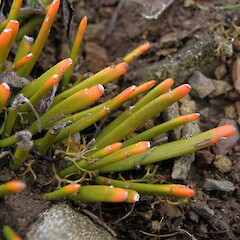Carmichaelia vexillata
Common name
Dwarf broom
Synonyms
None
Family
Fabaceae
Flora category
Vascular – Native
Endemic taxon
Yes
Endemic genus
No
Endemic family
No
Structural class
Trees & Shrubs - Dicotyledons
NVS code
The National Vegetation Survey (NVS) Databank is a physical archive and electronic databank containing records of over 94,000 vegetation survey plots - including data from over 19,000 permanent plots. NVS maintains a standard set of species code abbreviations that correspond to standard scientific plant names from the Ngä Tipu o Aotearoa - New Zealand Plants database.
CARVEX
Chromosome number
2n = 32
Current conservation status
The conservation status of all known New Zealand vascular plant taxa at the rank of species and below were reassessed in 2017 using the New Zealand Threat Classification System (NZTCS) – more information about this can be found on the NZTCS website. This report includes a statistical summary and brief notes on changes since 2012 and replaces all previous NZTCS lists for vascular plants.
Please note, threat classifications are often suggested by authors when publications fall between NZTCS assessment periods – an interim threat classification status has not been assessed by the NZTCS panel.
- Conservation status of New Zealand indigenous vascular plants, 2017 . 2018. Peter J. de Lange, Jeremy R. Rolfe, John W. Barkla, Shannel P. Courtney, Paul D. Champion, Leon R. Perrie, Sarah M. Beadel, Kerry A. Ford, Ilse Breitwieser, Ines Schönberger, Rowan Hindmarsh-Walls, Peter B. Heenan and Kate Ladley. Department of Conservation. Source: NZTCS and licensed by DOC for reuse under the Creative Commons Attribution 4.0 International licence.
2017 | At Risk – Declining | Qualifiers: DP, RF
Previous conservation statuses
2012 | At Risk – Declining | Qualifiers: DP, RF
2009 | At Risk – Declining | Qualifiers: RF
2004 | Serious Decline
Brief description
Rare low growing leafless shrub consisting of erect flattened yellow-green branches with a blunt orange or red tip. Branches 1.5-3 wide, grooved, tip rounded. Flowers pea-like, pink with darker streaks, in clusters. Fruit a dry sharp-tipped pod with many hard seeds and which does not split open.
Distribution
Eastern South Island to South Canterbury and Otago.
Habitat
Recent moraines, alluvium, river terraces, terrace risers, disturbed soils, and soils derived from schist parent material.
Detailed description
Dwarf, spreading broom, up to 15cm tall, 40cm wide. Stems stout, curved upwards or horizontal. Branchlets linear, 20-95mm long, 1.5-4mm wide, finely grooved, may be sparsely hairy when young, hairless at maturity; green-yellow, tips often red in winter. Simple leaves on seedlings and occasionally on mature plants, 4-7.5mm long, 2-4.5mm wide, with scattered hairs on both surfaces; leaves on flattened stems usually reduced to a hairless triangular scale. Flowers 4-5.5mm long, 2-2.5mm wide, in clusters of 2-3; purple with whitish margins, sometimes cream with purple veins; main petal upright and taller than lower petals, sepals hairless, tip of sepal long and pointed. Pod oblong, compressed, dark brown to black or light grey. Seeds 4-13 per pod, oblong, yellow to olive green with black mottling.
Similar taxa
Carmichaelia monroi, C. astonii, C. corrugata. C. vexillata has thin stems. The main flower petal is upright and taller than the two lower united petals. In C. monroi the main petal is smaller than the lower petals. C. astonii has hairy stems and is larger overall. C. corrugata has underground stems.
Flowering
October to March
Flower colours
Cream, Purple
Fruiting
November to May
Life cycle
Seeds are possibly dispersed by wind and granivory (Thorsen et al., 2009).
Propagation technique
Easy from fresh seed and semi hardwood cuttings. Dislikes humid climates.
Threats
At threat from weeds and browsing animals which inhibit flowering and fruit set. However, it must be recognised that without browsing animals many of the habitats occupied by this broom would vanish due to weed regrowth. This species survival now requires a delicate balance of allowing some browsing to reduce weeds but not too much which will damage or even kill Carmichaelia.
Etymology
carmichaelia: After Carmichael, a botanist
Attribution
Fact Sheet prepared for NZPCN by P.J. de Lange 1 August 2003. Description based on Heenan (1995)
References and further reading
Heenan, P. B. 1995: A taxonomic revision of Carmichaelia (Fabaceae-Galegeae) in New Zealand (part I). New Zealand Journal of Botany 33: 455-475.
Thorsen, M. J.; Dickinson, K. J. M.; Seddon, P. J. 2009. Seed dispersal systems in the New Zealand flora. Perspectives in Plant Ecology, Evolution and Systematics 2009 Vol. 11 No. 4 pp. 285-309
NZPCN Fact Sheet citation
Please cite as: de Lange, P.J. (Year at time of access): Carmichaelia vexillata Fact Sheet (content continuously updated). New Zealand Plant Conservation Network. https://www.nzpcn.org.nz/flora/species/carmichaelia-vexillata/ (Date website was queried)


















